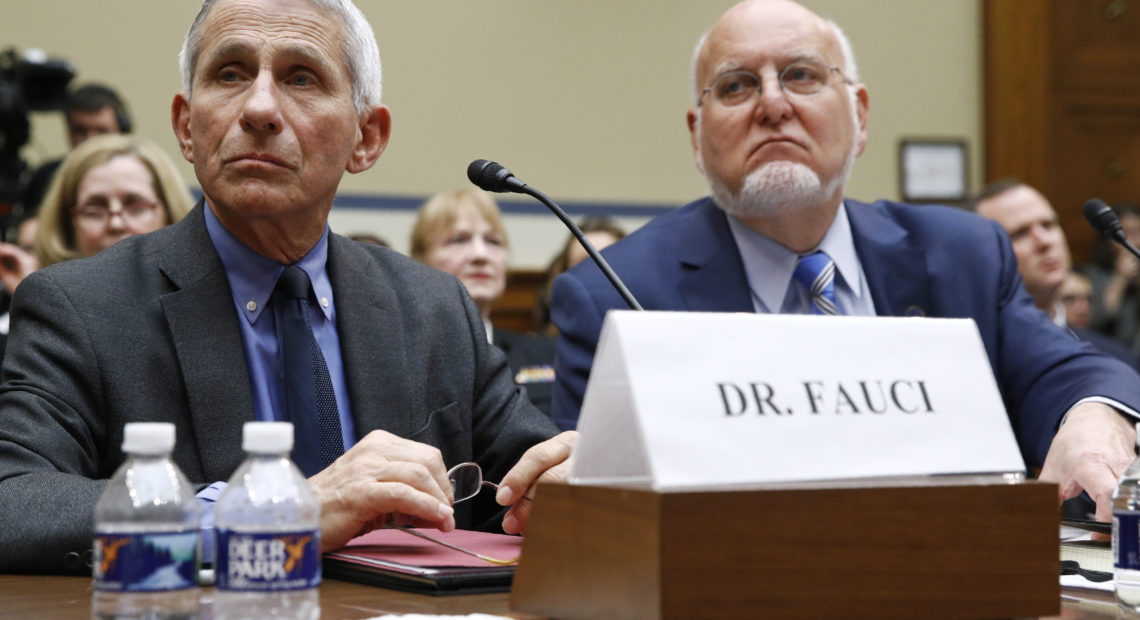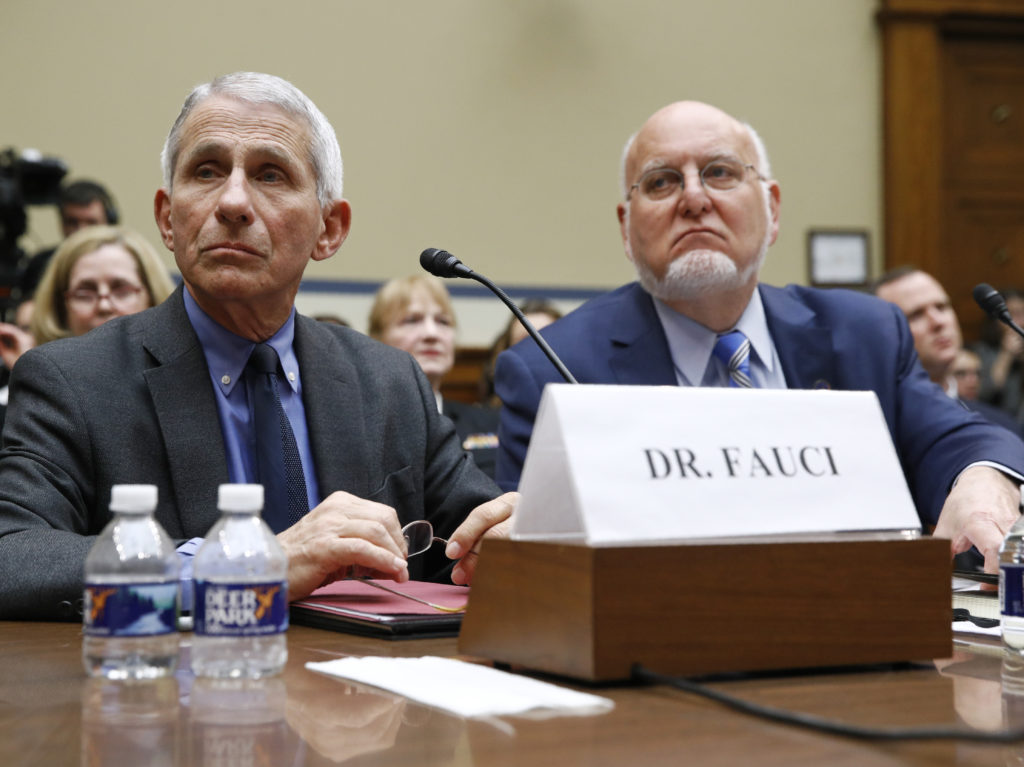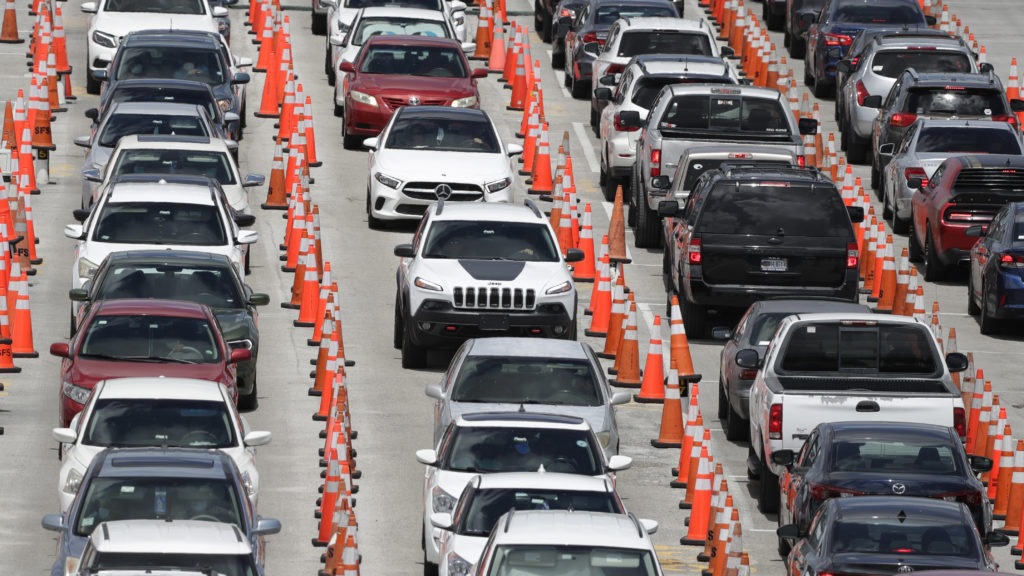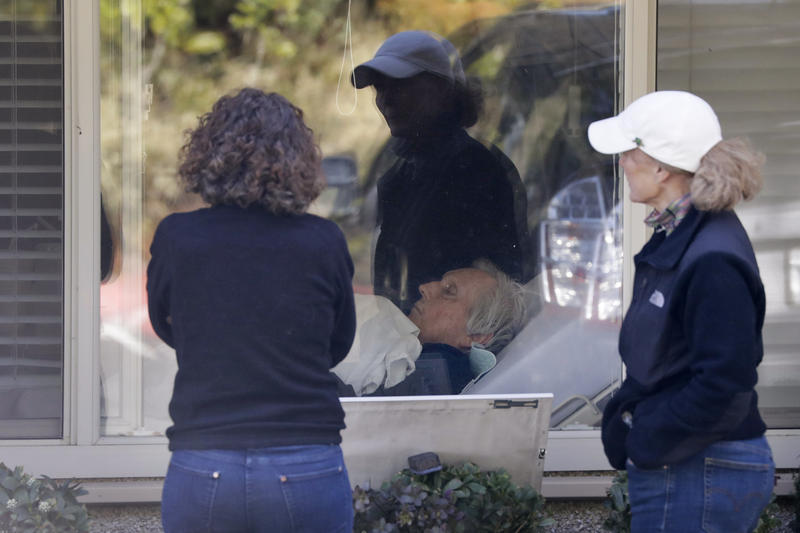
‘We Can’t Give Up’: U.S. Can Still Control The Spread Of COVID-19, Experts Say
BY LAURA SANTHANAM / PBS NewsHour
In the final days before voting wraps up in the 2020 presidential election, the United States has repeatedly broken its record for new daily cases of COVID-19 and seen hospitals overwhelmed with treating them.
Yet top officials from the Trump administration, including President Donald Trump himself, seem to reject the worsening conditions that could lead to tens of thousands more deaths. Instead, Trump has incorrectly suggested the country is “rounding the corner” on the pandemic, a leading adviser has floated talk of herd immunity and shared misinformation about face masks, while another senior official publicly stated that the U.S. strategy is not focused on curbing the virus’ spread.
ALSO SEE: Coronavirus News, Updates, Resources From NWPB
Public health experts and officials don’t agree that giving up control is a foregone conclusion, instead warning that steps can and must be taken now to avoid the unnecessary loss of life. And no credible experts have suggested the pandemic will end the day after voting stops, despite suggestions from Trump, who himself has tested positive for the virus, that the media is amplifying coverage of COVID-19 as a way to make him look bad.

Dr. Anthony Fauci, director of the National Institute of Allergy and Infectious Diseases, and CDC Director Robert Redfield appear before a Senate committee on May 12, 2020. CREDIT: Patrick Semansky/AP
How each candidate will handle the pandemic has become a critical part of the race for president, with Democratic nominee Joe Biden pointing to Trump’s mismanagement of the coronavirus leading to hundreds of thousands of deaths and Trump claiming that Democratic leadership would introduce widespread shutdowns that he believes could further damage the economy. For some voters, the coronavirus has also shaped the way they see the election and the candidates as their lives have changed. The third surge in COVID-19 cases has come as temperatures drop across much of the United States, keeping more people inside and raising the risk of spreading coronavirus if unchecked by masks or social distancing. Experts also fear that holiday travel and gatherings could fuel even more infections and suffering.
There is increasing concern among public health experts that the Trump administration has quietly adopted an implicit policy of natural herd immunity, or the idea that when enough people have become infected by a virus the rest of the population is indirectly protected. Despite spikes in positivity rates, resources and support for more testing and contact tracing have atrophied, suggesting that the U.S. is letting down its guard.
Without a shift, “We’re in for a whole lot of hurt,” the nation’s top infectious disease expert, Dr. Anthony Fauci, told the Washington Post. “It’s not a good situation.”
Fauci’s comments drew an angry rebuke from Trump during a Pennsylvania campaign rally on Sunday, where he threatened to fire the nation’s top infectious disease expert after the election.
Since the pandemic began, more than 9.2 million Americans have become infected with the coronavirus, and roughly 231,000 more have died. On Friday, the nation reported nearly 100,000 new cases in a single day, breaking a world record. The U.S. has been hit worse than any other country in the world, according to data from Johns Hopkins University. Dr. Eric Topol, a cardiologist, scientist and author who founded and directs the Scripps Research Translational Institute, said the U.S. appears to be on par with Iran, in that both countries are in a class by themselves in allowing the virus to go unchecked for so long and where evidence-based research and science have not guided the national response.
ALSO SEE: Coronavirus News, Updates, Resources From NWPB
“We’re basically just sitting ducks,” Topol said, who noted that he typically describes himself as an optimist. Looking at recent data, he pointed out on Twitter that rates of tests coming back positive have shot up while testing has decreased. Upper Midwestern states, including Wyoming and South Dakota, are reporting positivity rates between 45 and 55 percent, according to data from COVIDExitStrategy.org.
For months, Trump has said more testing leads to more cases, a claim that ignores that testing simply illuminates how pervasive infections already are. In August, the Centers for Disease Control and Prevention updated its guidance to say that asymptomatic people do not need to get tested for COVID-19, despite mounting evidence to the contrary. Weeks later, after protracted public outcry, the public health agency reverted to its original guidance.
The U.S. has never mounted adequate national testing and contact tracing efforts so that people could get results quickly enough to know whether they should quarantine or not. That has also translated into uncertainty about how great a toll COVID-19 has exacted on the country so far. New numbers from the Centers for Disease Control and Prevention suggest excess deaths — deaths that surpass what health statisticians expected to see in a given year based on a host of demographic data and pre-existing disease trends — is higher than expected.
“We’re not going to control the pandemic,” Mark Meadows, Trump’s White House chief of staff, told CNN host Jake Tapper on Oct. 25. Instead, he said, that the nation would rely on the approval of vaccines and medications to gain the upperhand over the virus. But that process could take months and is further complicated by the public’s decreased willingness to be vaccinated for COVID-19, a problem experts said might be aggravated by the injection of politics into science.

Cars line up for coronavirus testing outside Hard Rock Stadium in Miami Gardens, Fla. Florida is one of many states reporting spikes in COVID-19 cases in recent days, as the number of confirmed cases worldwide has topped 10 million.
CREDIT: Wilfredo Lee/AP
Despite what the Trump administration has said, experts who spoke with the PBS NewsHour point to the pillars of public health — testing, contact tracing, isolating — as reliable ways to control the virus, even when faced with surges. When those strategies are in place, the virus ultimately gets boxed in. But when a majority of states report uncontrolled spread and when testing is not fully stood up, contact tracing efforts are overwhelmed. Without a firmer grasp of confirmed cases, you easily lose track of who may have been exposed, may need testing and should quarantine.
Across the country, Americans are simply tired of the pandemic. COVID-19 fatigue is real and a lack of infrastructure worsens this sense of resignation, said Dr. Stefan Baral, associate professor in epidemiology and international health at the Johns Hopkins School of Public Health. For example, he said, while there has been a huge push to ramp up testing strategies to diagnose people, “testing is only an intervention if someone is empowered to react to the results.”
If someone gets tested, finds out they have COVID-19 and is told they need to isolate to prevent infecting other people, that assumes a lot about that individual’s depth of resources, Baral said. For many people, particularly in households with low-incomes and disproportionately in communities of color, they fear losing their job and their ability to pay rent if they quarantine, he said.
“It’s a response designed for people of means,” he said.
Between Jan. 26 and Oct. 3, researchers estimate that 299,028 excess deaths occurred, two-thirds of which were linked to COVID-19.
CDC data show Hispanic Americans have suffered disproportionate more severe health outcomes and death compared to others. This year, excess deaths within Hispanic communities rose 53.6 percent over the previous year — more than any other race or ethnic group in the U.S. By comparison, these deaths among whites went up 11.9 percent over last year — the smallest increase by race and ethnicity.
In recent weeks, Dr. Scott Atlas, a neuroradiologist who lacks expertise in infectious diseases or epidemiology yet leads the White House coronavirus task force, has drawn scrutiny for suggesting that there was “likelihood that only 25 or 20 percent of people need the infection,” to achieve herd immunity, The New York Times reported. Scientists and health experts were outraged by the comment, saying this claim was irresponsible, unethical and if put into practice, could result in the unnecessary sickness and deaths of thousands more Americans. A growing number of Americans have reported long-term lingering effects of their COVID-19 infection that change their physical ability, cognition and mood.
ALSO SEE: Coronavirus News, Updates, Resources From NWPB
His call for natural herd immunity has been supported by a small band of voices scattered across Europe, the U.S., Canada and New Zealand. On Oct. 4, 45 doctors signed a declaration, arguing that social distancing places too great a burden on people and that those “who are at minimal risk of death to live their lives normally to build up immunity to the virus through natural infection,” while offering “focused protection” to those who might be predisposed to worse outcomes.
In response, more than 6,400 scientists, researchers and clinicians collectively disagreed with this call for natural herd immunity. Together, they signed a memorandum that called it “a dangerous fallacy unsupported by scientific evidence.” And Fauci has called the declaration for herd immunity “nonsense.”
Without a widespread vaccination campaign underway, natural herd immunity “presumes doing nothing,” Baral said.
That approach contradicts fundamental public health practice, he said, where you address “unmet needs with services and support.” Regaining control over the virus, particularly among marginalized communities that have suffered disproportionately worse outcomes and higher rates of death throughout the pandemic, Baral said, “That’s not something that gets solved passively.”

Sisters Seri Sedlacek, left, and Susan Simpkins look in on their father, Chuck Sedlacek, at the Life Care Center in Kirkland, Washington, Wednesday, March 18, 2020. CREDIT: Elaine Thompson/AP
Even if the U.S. were to adopt natural herd immunity until a vetted vaccine is available and vaccination campaigns inoculate enough people, marginalized communities would continue to suffer the brunt of COVID-19, said Dr. Uché Blackstock, Yahoo News medical contributor and emergency physician.
“There’s no possible way to have a strategy where you have younger, healthier people out there living life as normal without impacting vulnerable groups,” Blackstock said. “There’s no sort of situation where we could see that happening in a safe way.”
In Europe, France, Germany and the United Kingdom have announced new lockdowns, while those calls have been far more sporadic in the U.S. In Chicago, all indoor dining has been banned, and all bars and restaurants must close by 11 p.m. in response to a surge in cases earlier in October. Rather than present a unified front against a single virus, the U.S. has collected a patchwork of uneven measures instead. With the virus picking up speed again, American public health experts say these more extreme measures will be needed to snuff out the virus and prevent more people from getting sick and dying and avoiding pushing health care systems to the brink of collapse. Trump, however, has bashed lockdowns and criticized Europe for taking such measures to protect people.
“Europe imposed draconian lockdowns and cases were surging and deaths were surging but think of it, draconian. Now they have to do it all over again. What the hell are they doing? I think I’ll go over and explain it to them,” he said during a rally in Michigan, according to CNN.
Since the Trump administration lifted federal social distancing guidelines in the spring, state governments have had to pick up the slack in the pandemic response, picking up and dropping strategies that could influence the risk of transmitting the virus, such as face mask mandates and reopening bars and restaurants when cases are still rising. That means the U.S. has at times had 50 different strategies in play for responding to COVID-19.
The White House has been a wellspring for misinformation and conflicting guidance about basic public health measures, like wearing face masks, despite a growing body of evidence showing their effectiveness. In a single week, Trump said in one interview that he thought mask-wearing was effective in controlling the spread of the virus, and in a rally falsely claimed that 85 percent of people who wear face masks get coronavirus. Sixty-three percent of likely voters said they supported a mask mandate in an Oct. 15 PBS NewsHour/NPR/Marist poll, a measure that Biden has supported and one that has gained support among public health experts, including Fauci. Biden’s team “is taking it seriously from a public health perspective,” Fauci told the Washington Post.
During an Oct. 27 call with reporters, Ryan Panchadsaram, who co-founded CovidExitStrategy.org to monitor how states were responding to the pandemic, urged the need for continued commitment as most states appear to be in the grips of uncontrolled spread.
ALSO SEE: Coronavirus News, Updates, Resources From NWPB
The election will in part determine whether states and individuals will be left on their own to rein in the crisis, or if a new administration will offer a more unified national approach. More than two-thirds of Americans say the coronavirus pandemic is a real threat, according to an Oct. 15 PBS NewsHour/NPR/Marist poll, and another 28 percent say it has been blown out of proportion.
Polls show that Americans’ faith in sources of information about the pandemic has eroded since March, suggesting that Trump’s attacks have sowed doubt. While roughly a third of the public trusted Trump’s message about the pandemic, a Sept. 18 PBS NewsHour/NPR/Marist poll said 69 percent of Americans said they believed most of what they heard from public health experts. That was down significantly from March when 84 percent of Americans said they trusted what they heard from those experts.
The U.S. can regain ground through the transparent use of data tracking the virus at all levels, as well as embracing “the five W’s” of wearing face masks, washing hands and watching distance, Panchadsaram said, adding that persistence is “the only way to truly crush this virus.” But experts wonder if the nation’s leaders have already abandoned those strategies. Despite past mistakes, Panchadsaram said, “To beat this virus, we can’t give up.”
Copyright 2020 PBS NewsHour. To see more, visit pbs.org/newshour















